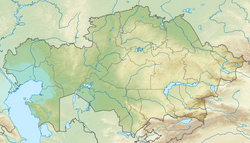Caspian Depression
This article includes a list of general references, but it lacks sufficient corresponding inline citations. (February 2008) |
Caspian Depression | |
|---|---|
 Caspian Depression and north Caspian Sea from space. NASA photo | |
| Coordinates: 47°32′N 49°00′E / 47.53°N 49°E | |
| Area | |
| • Total | 200,000 km2 (77,000 sq mi) |
The Caspian Depression (
The level of the Caspian sea is 28 metres (92 ft) below sea level, however several areas in the depression are even lower, and among them Karagiye near Aktau is the lowest at −132 metres (−433 ft).
Geography
The depression is in the northeastern part of the East European Plain and covers parts of Kazakhstan and Russia. In Kazakhstan it covers parts of Atyrau Region, West Kazakhstan Region, and Mangystau Region. In Russia it covers parts of Dagestan, Kalmykia, Saratov Oblast, Volgograd Oblast, Astrakhan Oblast, and Stavropol Krai. In the Horth it is bounded by Obshchy Syrt highland; in the West by Volga Upland, Yergeni, and Stavropol Upland; in the east by Ustyurt Plateau and Sub-Ural Plateau (a.k.a. Cis-Ural Plateau, Pre-Ural Plateau, Poduralskoe Plateau)[2] It significantly overlaps with the Ryn Desert.
The
.The North Caspian depression is part of the
The Caspian Depression is below sea level, consisting of large areas of
The depression is also noted for salt domes, particularly Volgograd salt. It increases dramatically as one travels from the Ryn Desert toward the Caspian Sea. Russian satellite photos have revealed huge deposits of salt domes (about 1,200), in the Caspian Depression in western Kazakhstan. One dome, called the Chelkar Deposit, covers an area of 3,237 km2 (1,250 sq mi) and is nearly 8 kilometres (5 mi) deep.
The southern region of the depression, or the north coast of the Caspian Sea, is characterized by the large development of damp sites resulting from
The highest point in the depression is Mount Bogdo (152m above the sea level).
See also
References
- ^ "Caspian Sea » Background". Caspian Environment Programme. Archived from the original on 2006-04-08. Retrieved 2011-02-24.
- ^ Прикаспийская низменность, Great Russian Encyclopedia
- Evaporites of North Border of North Caspian Depression – Internet Geology News Letter No. 178, January 13, 2003.
- Space Today Online.


